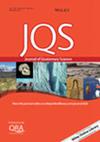Grain-size evidence of Middle Pleistocene sedimentary environmental changes in the eastern Tai-hang Mountains, North China
Abstract
Grain size is a proxy for climate and environmental change, and the results of grain size analyses can be used to infer the conditions and environment under which the sediments were formed. The eastern foothills of the Tai-hang Mountains in northern China are on the edge of the East Asian Summer Monsoon and are extremely sensitive to climate and environmental changes. Understanding the ecological changes in this region is vital for coping with future climate change and solving related climate and environmental problems. This study uses parametric grain size end-member analysis to discuss the depositional dynamics and ecological changes in the Middle Pleistocene of the Shijiazhuang JingXing YF profile. The results indicate that: (1) The OSL dates of the YF profile vary from 274 to 0.997 ka, and sedimentation began in the Middle Pleistocene. (2) The YF profile's sediments’ grain size is separated into four end elements: EM1 is the clay fraction produced by loam-forming action; EM2 and EM3 are long-distance transported fine silt and short-distance transported silt at low altitudes, representing the variation in East Asian Summer Monsoon intensity; EM4 represents the near-surface transported coarse silt fraction driven by East Asian Winter Monsoon power. (3) The grain size index reconstructed the paleoclimate of the Middle Pleistocene in the Shijiazhuang area, and it can be divided into four stages: 274–210 ka, the climate changed from cold to warm; 210–170 ka, was a warm period; 170–80 ka, the climate changed from warm to cold; and from 80–1 ka was a cold period. Multi-indicator comparisons show that the monsoon evolution recorded in the Middle Pleistocene YF loess-paleosol sequence is fundamentally consistent with changes in mid- to high-latitude solar radiation, and changes in solar radiation modulate that monsoon changes in East Asia.

 求助内容:
求助内容: 应助结果提醒方式:
应助结果提醒方式:


